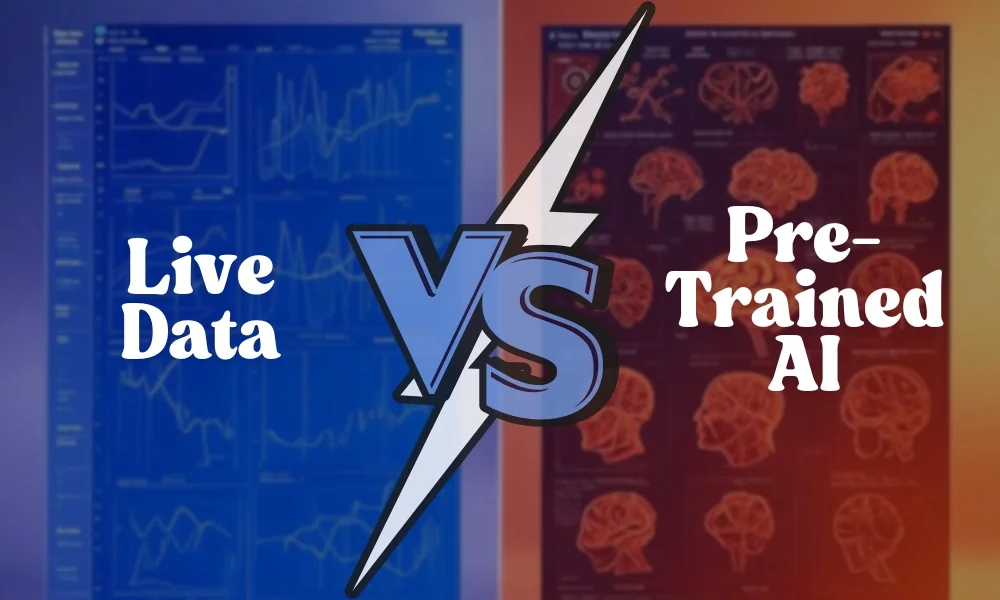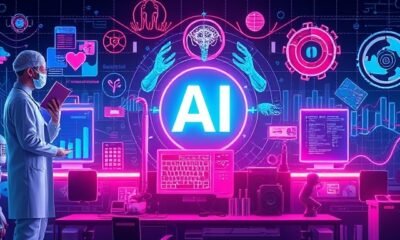Artificial Intelligence
Live Data vs. Pre-Trained AI: Why Web Search Features Matter
Uncover how live data delivers real-time updates for accurate AI search results, while pre-trained AI relies on static knowledge for faster responses. This article breaks down their differences and explains why web search capabilities are key to modern AI tools.

Artificial intelligence is transforming the way I search for information, but not all AI models work the same way. Some rely on live data, while others depend on pre-trained AI models. This difference affects the accuracy, relevance, and usability of AI-powered tools.
Understanding AI Search Models:
Live data updates in real-time, fetching the latest results from the web. On the other hand, pre-trained AI relies on previously stored knowledge without direct access to the internet. This contrast plays a major role in how I interact with AI search features every day.
In this article, I’ll break down the differences between live data and pre-trained AI and explain why web search capabilities are crucial. You’ll learn how these technologies impact data accuracy, AI personalization, and overall search engine trends. After reading this you will decide which system suits your requirements best.
Understanding the Basics: The Core Differences Between AI Models
What is Live Data?
Live data refers to real-time data that updates instantly by pulling information from the internet. The system provides access to latest information about any matter at my convenience. Web search features play a huge role in delivering these updates.
Examples of AI Using Live Data:
-
Google Search and Bing provide instant results with the latest indexed content.
-
AI chatbots with web access, like Perplexity AI, retrieve fresh information instead of relying on past knowledge.
-
News aggregators and stock market trackers update in real-time based on current events.
Live data ensures I always have the most relevant and accurate information, making it essential for time-sensitive queries like breaking news or financial updates.
What is Pre-Trained AI?
Pre-trained AI models are built using machine learning techniques and trained on a large dataset before they are deployed. Unlike live data systems, they do not update automatically unless manually retrained with new information.
Examples of Pre-Trained AI Models:
-
ChatGPT-4 and Claude generate responses based on data they learned before their last update.
-
Gemini (in offline mode) relies on past training without pulling data from live search results.
-
AI writing assistants use stored patterns to generate text without checking for the latest trends.
While pre-trained AI offers AI personalization and quick responses, it lacks dynamic search capabilities. The system provides limited benefit for subjects that need current information.
Key Differences Between Live Data and Pre-Trained AI: What Sets Them Apart?
Real-Time Updates vs. Static Knowledge: Which One Stays Current?
Live data provides real-time data by continuously pulling the latest information from web search results. The live data system provides me with contemporary research information during my investigations into trending news and financial developments and technological advancements.
In contrast, pre-trained AI relies on static knowledge from past training. The lack of live updates in this system leads to presenting information that might be outdated or contain missing elements. Without a dynamic search feature, pre-trained models can’t adjust to rapidly changing events.
Accuracy and Relevance: Which One Provides Better Information?
A strong AI search feature must balance data accuracy and relevance. Live data systems, like search engines, fetch the latest results, increasing their reliability for time-sensitive topics. These systems obtain their data from outside sources yet they might distribute false information.
On the other hand, pre-trained AI can deliver consistent responses, but its knowledge becomes less relevant over time. An AI model which fails to receive updates for months will lack important recent information thus reducing its utility for immediate decision support.
Speed and Accessibility: Which AI Model Responds Faster?
Pre-trained AI models deliver instant responses because they generate answers from stored knowledge. I can ask a question and receive a result in seconds without waiting for a web search to fetch external data.
Live data systems, however, take longer because they need to search, verify, and compile results. While this process ensures greater data accuracy, it may slow down response times compared to machine learning models that rely on past training.
Reliability and Fact-Checking: Which One Can Be Trusted?
Live data tools depend on search engine trends and external sources, requiring careful fact-checking. I need to check the credibility of information because search results originate from numerous websites. The search results might occasionally include misinformation or biased content.
Pre-trained AI may avoid unreliable sources, but it isn’t perfect. The artificial intelligence systems produce misleading information through “hallucinations” in their output. Without AI personalization or web access, they can’t validate facts in real-time, increasing the risk of errors.
How Web Search Features Enhance AI: The Power of Real-Time Data
Improving Accuracy with Fresh Data: Why Web Search Matters?
AI models with web search access can pull real-time data, making them far more accurate than pre-trained AI models. The search engine-powered Perplexity AI platform provides current information that lowers the chances of delivering obsolete content.
Without AI search features, pre-trained models rely only on past training, leading to gaps in knowledge. This makes web-connected AI a better choice for topics that require data accuracy, such as medical updates, technology advancements, and stock market trends.
Combining AI Reasoning with Web Search: How Does It Work?
Some AI models blend machine learning reasoning with real-time search to improve responses. For example, Bing AI combines its AI-generated insights with search engine trends, ensuring the information is both logical and current.
By integrating dynamic search capabilities, AI can analyze context, verify facts, and refine responses before delivering an answer. AI-powered insights become available to me through this method which also delivers the most current web-based information.
Real-Time Event Awareness: Why Do Live Updates Matter?
Linked AI models automatically detect emerging news stories as well as popular trending topics at real time. Whether it’s financial reports, sports scores, or political updates, real-time data ensures I always receive the most recent and relevant details.
In contrast, pre-trained AI lacks awareness of ongoing events. A model trained six months ago will not detect important changes thus becoming unreliable for urgent choices. AI search features help solve this problem by keeping AI informed.
Reducing Hallucinations: Can AI Cite Sources?
One major issue with pre-trained AI is hallucination—when an AI confidently provides false information. AI models that integrate web search can reduce this risk by citing sources and cross-checking details before delivering an answer.
The references included with AI-generated research responses increase my trust in their accuracy. Web-connected AI tools improve AI personalization by adapting to search engine trends, ensuring the data is verifiable and credible.
Use Cases: When to Choose Live Data vs. Pre-Trained AI?
Choosing between live data and pre-trained AI depends on the situation. Some tasks require real-time data, while others work best with AI trained on past knowledge. The selection between these tools at appropriate times allows me to generate better decisions and obtain the most precise results.
Best for Live Data: When Real-Time Updates Matter?
Live data is essential for tasks that require dynamic search and instant updates. Web-connected AI provides better accuracy and up-to-date information thus making it the preferred choice when accuracy matters.
Top Use Cases for Live Data:
-
Financial Market Updates: Stock prices and cryptocurrency values change every second. AI models with web search access can track these shifts and provide the latest insights.
-
Breaking News and Current Events: AI that pulls real-time data from news sources ensures I stay informed about global events, politics, and trending stories.
-
Fact-Checking and Research: When verifying claims or searching for sources, AI search features help find the most reliable and up-to-date information.
Best for Pre-Trained AI: When Stored Knowledge Works Best?
Pre-trained AI models excel at tasks that don’t require immediate updates. If I need creativity, structured knowledge, or technical assistance, an offline AI model is usually the better choice.
Top Use Cases for Pre-Trained AI:
-
Writing Assistance and Brainstorming: AI models like ChatGPT-4 and Claude help generate ideas, improve grammar, and refine content without needing real-time data.
-
Code Generation and Problem-Solving: AI tools trained on vast codebases provide solutions to programming challenges and offer debugging assistance without needing a web search.
-
Conversational AI and General Knowledge: Virtual assistants, chatbots, and knowledge-based AI models work well for answering common questions without requiring constant updates.
By understanding these use cases, I can decide when to rely on live data for accuracy and when to use pre-trained AI for structured knowledge. This balance helps me get the best results for different tasks.
Challenges and Limitations: What Are the Downsides?
Both live data and pre-trained AI have strengths, but they also come with limitations. Understanding these challenges helps me make better choices when using AI for different tasks.
Live Data Issues: What Are the Risks?
While real-time data improves accuracy, it also introduces challenges that can affect reliability and performance.
-
Misinformation Risks from Unreliable Sources: AI models that rely on web search pull information from multiple sites, some of which may be biased or inaccurate. This increases the risk of misinformation if sources aren’t properly verified.
-
Slower Response Time Compared to Pre-Trained AI: Unlike pre-trained AI, which generates answers instantly, web-connected AI needs time to search, filter, and verify results. This delay can be frustrating when I need quick responses.
Pre-Trained AI Issues: What Are the Limitations?
Since pre-trained AI doesn’t have dynamic search features, it faces challenges in keeping up with the latest information.
-
Can’t Access New Data Unless Retrained: AI models like ChatGPT-4 and Claude only know what they were trained on. Without real-time data, they can’t provide updates on recent events, market trends, or breaking news.
-
Risk of Outdated or Incorrect Information: Since these AI models don’t have web access, they might deliver old or inaccurate responses. Without an AI search feature, they can’t verify facts, which can lead to errors.
Conclusion:
Live data ensures AI models stay updated with real-time data, making them ideal for fact-checking, news updates, and research. Pre-trained AI offers fast responses and structured knowledge, making it great for writing, coding, and general inquiries.
The ideal AI model does not exist as a stand-alone solution. The most powerful AI search features blend machine learning, web search, and stored knowledge. This approach delivers data accuracy, fast responses, and improved reliability.
Which type of AI do you prefer for your daily tasks, live data for accuracy or pre-trained AI for speed? Share your thoughts in the comments!
-

 Artificial Intelligence4 months ago
Artificial Intelligence4 months agoWhat is Artificial Intelligence? A Comprehensive Guide for Businesses and Enthusiasts
-

 Artificial Intelligence1 month ago
Artificial Intelligence1 month agoHow to Use Grok AI: A Complete Guide
-

 Artificial Intelligence3 months ago
Artificial Intelligence3 months agoWhat is DeepSeek? Revolutionizing AI with Cutting-Edge Solutions
-

 Artificial Intelligence3 months ago
Artificial Intelligence3 months agoUnlocking the Power of Artificial Intelligence Tools
-

 Artificial Intelligence3 months ago
Artificial Intelligence3 months agoWhat is Quantum Artificial Intelligence? How It Works and Why It Matters
-

 Artificial Intelligence2 months ago
Artificial Intelligence2 months agoChallenges and Ethical Considerations Of Using Al In Predictive Policing
-

 Artificial Intelligence3 months ago
Artificial Intelligence3 months agoArtificial Intelligence in Education: Transforming Learning Experiences
-

 Artificial Intelligence3 months ago
Artificial Intelligence3 months agoUnlocking the Power of ChatGPT: A Beginner’s Guide to AI Conversations




